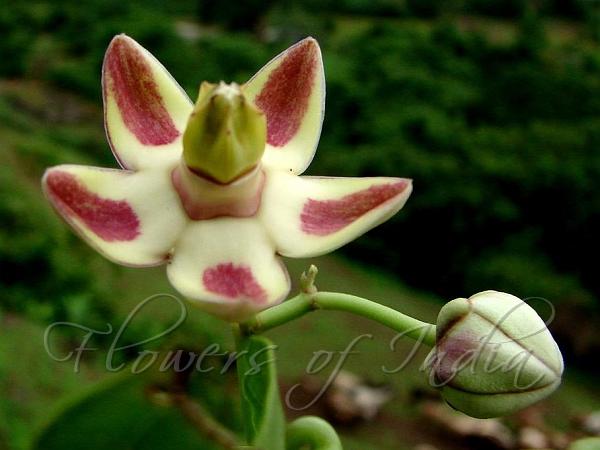|
| Ringed Swallow-Wort |
|

|

| File size | 87948 |
| Original date | 7/7/07 5:21 PM |
| Resolution | 1024 x 683 |
| Flash | Flash did not fire, auto |
| Focal length | 6.0mm |
| Exposure time | 1/320s |
| Aperture | 4.0 |
| Focus Distance | |
| Metering Mode | Spot |
| Camera make | SONY |
| Camera model | DSC-H1 |
| Sensor type |
|
|
|
|
Photo: |
Botanical name: Cynanchum annularium Family: Apocynaceae (Oleander family)
Synonyms: Holostemma ada-kodien, Asclepias annularia, Holostemma annulare
Synonyms: Holostemma ada-kodien, Asclepias annularia, Holostemma annulare
Ringed Swallow-Wort is a handsome, extensive, laticiferous, twining shrub
with large conspicuous flowers. The bark is deeply cracked. The leaves are
ovate to heart-shaped, 5-12 × 2-8 cm, coriaceous, acute, smooth above, and
finely pubescent. The flowers are greenish-yellow in color, purplish
crimson inside, in lateral cymes. The petals are thick, typical of the
milkweed family. Flowers are very fragrant. The central crown is edible.
The fruits follicles sub-woody, 6-9 cm long, tapering and green. The roots
are pretty long up to a meter or more in length, thick, cylindrical and
irregularly twisted. It grows over hedges and in open forests especially on
the lower slopes of hills. Ringed Swallow-Wort is found from the
Indian Subcontinent to S. China, including the Himalayas.
Flowering: April-September.
Medicinal uses: Mainly the roots and the whole
plant are used for medicinal purposes. Externally the paste of its
leaves and roots alleviate oedema due to vitiation of pitta dosa. The
herb is beneficial for external use in various skin diseases, wounds
and inflammation of the skin.
Mainly the roots and the whole
plant are used for medicinal purposes. Externally the paste of its
leaves and roots alleviate oedema due to vitiation of pitta dosa. The
herb is beneficial for external use in various skin diseases, wounds
and inflammation of the skin.
Medicinal uses:
 Mainly the roots and the whole
plant are used for medicinal purposes. Externally the paste of its
leaves and roots alleviate oedema due to vitiation of pitta dosa. The
herb is beneficial for external use in various skin diseases, wounds
and inflammation of the skin.
Mainly the roots and the whole
plant are used for medicinal purposes. Externally the paste of its
leaves and roots alleviate oedema due to vitiation of pitta dosa. The
herb is beneficial for external use in various skin diseases, wounds
and inflammation of the skin.| Identification credit: Nandan Kalbag | Photographed in Maharashtra. |
• Is this flower misidentified? If yes,